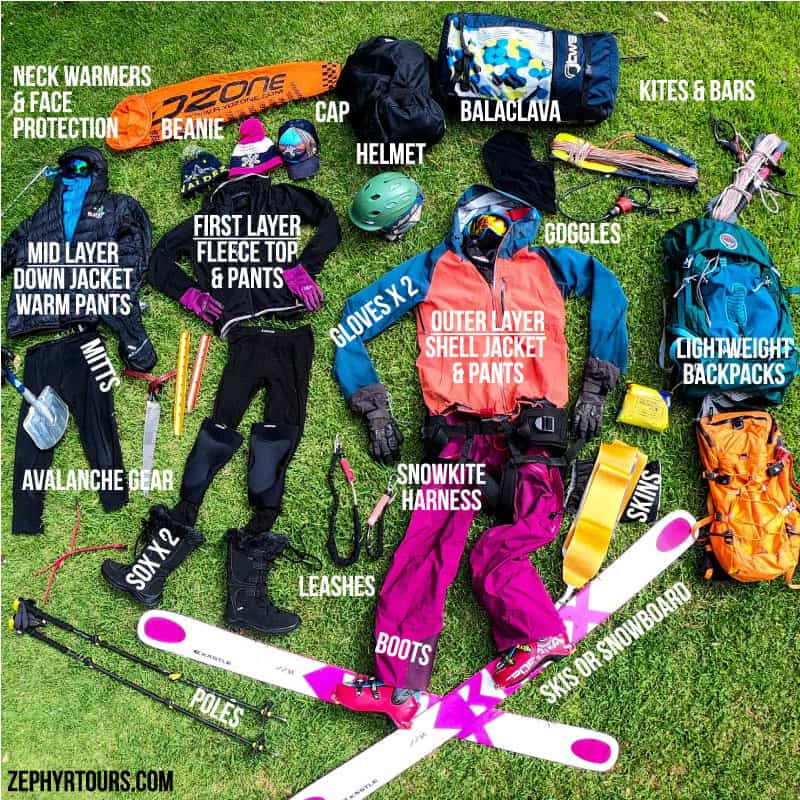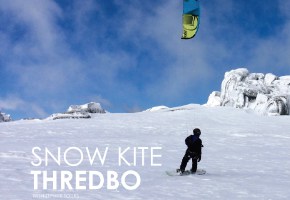Snowkiting is a relatively new extreme sport which combines either skiing or snowboarding with a kite.
Think kiteboarding on snow!
If you enjoy snowsports and kiting on the ocean then it is a fantastic opportunity to combine your two loves.
Ocean attire is obviously not going to work in your favour in snow conditions. Proper clothing and layering are the key ingredients to an enjoyable snowkiting session. It is recommended that you dress similar to skiing; be prepared to become warm during the high-energy sport but also prepare for the cold, especially when considering your extremities.
Necessities:
Necessities include a base layer and an outer shell for insulation to keep the wind and snow at bay. It is helpful for the outer shell to be long, with a hood.
On particularly cold days, we recommend additional synthetic base layers or that can easily be removed if you find that you are overheating. Our professional snowkiter, Jennie Milton recommends that you wear a warm, waterproof layer OVER your shell that can be removed; that way you do not have to remove your shell to take off the layers underneath and lose essential body heat.
Your snow pants are likely to get wet so a high waterproof rating is needed to keep you dry through the thrills and spills. The minimum recommended breathability and waterproof rating is 10,000mm or 10k. A 20,000+mm rating will provide the ultimate durability. A snow bib is a great option if you are snowkiting in powder.
We are big fans of layering gloves just as you would clothes; adding an additional liner to your glove can make your hands up to 30% warmer! It is possible to layer gloves without losing your dexterity.
Other primary requirements include a helmet, goggles and a synthetic balaclava/face mask to protect you from the wind. A thin beanie to wear under your helmet can also work wonders in keeping you warm.
Your clothing and gloves should not fit too tight. If they are too tight, heat is not able to circulate. It should evidently not be too large either to allow cold drafts to enter. It’s essential to fit the “sweet spot” of clothing to ensure maximum warmth.
Materials:
Cotton should be avoided at ALL COSTS (even down to your underwear)! While it is lightweight, it has no ability to “wick” moisture. Instead, cotton absorbs, so it will remain weight and become increasingly heavy.
Even though down is the best overall insulator available, we do not recommend it for sweat-producing activities. It is useless when it becomes wet.
Wool is a good alternate option as it can absorb a lot of moisture before it will start to feel wet, is very durable and can be very warm. It can, however, become very heavy when wet and takes a long time to dry.
Fleece is the best option as it has the same insulation properties as wool at half the weight. It is easy to take care of and very durable, breathable and dries quickly. It is a great option as a mid-layer for high energy activities.
Outer shell: There are many different material options for shells available on the market. We recommend that you select a shell that is wind-proof, water-proof, lightweight and able to breathe. This layer does not need a lot of insulation if you are relying on other layers to keep you warm.
Harness:
Climbing-style harnesses have become popular with snowkiters. Often you will need to tour on skis or a split board to reach your destination, so it is a great, lighter-weight option to the regular harness that you would use on the ocean. Additionally, a lightweight harness is a lot easier to combine with your layering scheme.
Hot tip: make sure that there are no friction points available (especially on your hips!).

We hope that this has provided some useful guidelines to help keep you warm while you are out shredding on the snow!
If you are keen to take on snowkiting as your next sport, or already rip on the mountains, join us on our epic Alaskan adventure or Learn to snowkiting in Thredbo, Australia with professional snowkite & skier Jennie Milton and friends.


Stay happy, stay warm and go kiting!
Heather Menaglio

